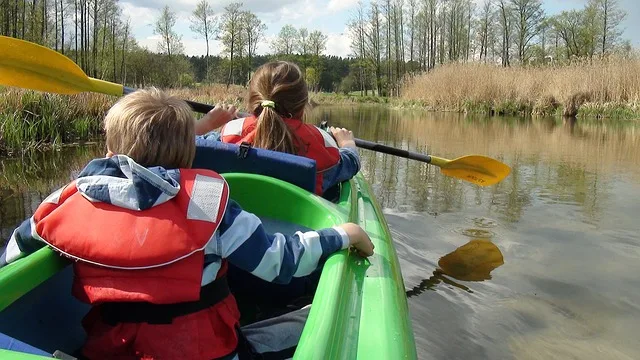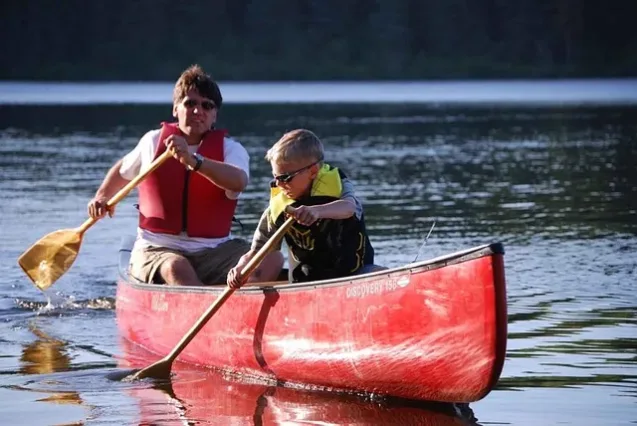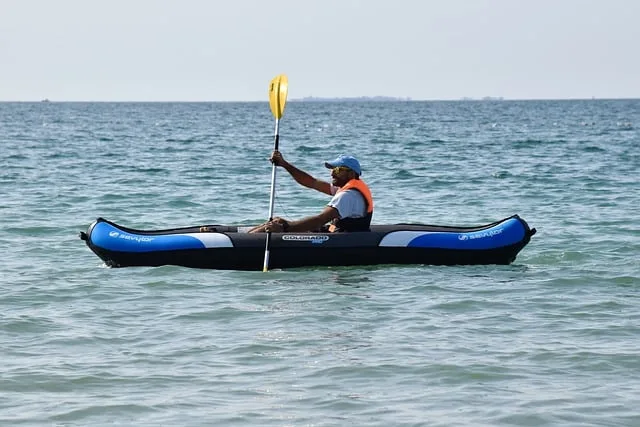Kayaking is a fantastic way to explore the UK’s stunning waterways and picturesque coastlines. Whether you’re a beginner or an experienced paddler, there’s always something new to discover. However, if you’ve never been kayaking in the UK before, it can be a daunting experience. In this guide, we’ll share some tips to help you get started with kayaking in the UK.

What is Kayaking?
Kayaking is involves paddling a small watercraft, called a kayak, through water. Kayaks can be made of various materials like plastic, fiberglass, wood or inflatable materials. They are propelled by a double-bladed paddle and can be used on various types of water, from calm lakes to fast-moving rivers and even in the ocean.
Kayaking can be done solo or with a partner, and it’s a great way to enjoy nature and get some exercise.
What is the Difference between a Kayak and a Canoe?
While kayaks and canoes are both small watercraft designed to be paddled by one or more individuals, they have some distinct differences:
- Design: Kayaks are typically smaller and narrower than canoes, and they typically have a closed cockpit that covers the legs and hips. Canoes are usually wider, have an open top, and have high sides to protect the paddler from water splashing.
- Paddle: A kayak is typically propelled with a double-bladed paddle, while a canoe is usually propelled with a single-bladed paddle.
- Position: When paddling a kayak, the paddler sits low to the water with the legs stretched forward, using a backrest for support. When paddling a canoe, the paddler typically kneels on the bottom of the boat or sits on a seat, using their knees against the sides for support.
- Use: Kayaks are best suited for faster and more aggressive water sports, such as white water kayaking or sea kayaking. Canoes are more versatile, and can be used for many different activities, including leisurely lake paddling, fishing, and family outings.
In summary, the main differences between canoes and kayaks are the design, paddle, position, and use.

Do I need to be Experienced to go Kayaking?
No, you do not necessarily need prior experience to go kayaking. Kayaking is a relatively easy and safe activity that can be enjoyed by people of all ages and skill levels. Many people are able to learn how to kayak on their first try. However, it is important to follow some safety guidelines and get some basic training before you start kayaking, especially if you plan to go on more challenging waters.
If you’re a beginner, it’s best to start with flat and calm waters and practice basic kayaking techniques, such as how to hold the paddle, how to steer the kayak and how to get in and out of the kayak properly.
It is always recommended to wear a lifejacket or personal flotation device, and to paddle with a partner or in a group. As you gain more experience and confidence, you can gradually move on to more challenging waters and techniques.
Location, Location, Location
When planning your first kayaking trip, it’s essential to consider the location. The UK has numerous waterways and coasts to explore, from gentle rivers and canals to choppy seas and white water rapids. However, it’s important to choose the right site for your skill level.
For beginners, we recommend sticking to slow-moving waters such as canals, lakes, or sheltered bays. Avoid venturing into open water until you have built up some experience and confidence.

Choose the right Kayak
Selecting the right kayak is critical to your safety and enjoyment while paddling. The type of kayak you need will depend on the location, conditions, and your personal preference.
A sit-on-top kayak is the most popular option for beginners. They’re stable, easy to manoeuvre, and user-friendly. They also provide a higher level of comfort and easier entry and exit than a traditional sit-inside kayak. Make sure your rental company provides you with proper paddles and a life jacket.
Are Kayaks Expensive?
The cost of a kayak can vary depending on the type, size, and material used to make it. Typically, kayaks can range from a few hundred pounds to several thousands!
Entry-level recreational kayaks made with plastic can cost around £200-£600, while more advanced kayaks made with fiberglass or carbon fibre can cost over £1000.
Inflatable kayaks are generally less expensive than hard shell kayaks and can cost from around £100.
The price of a kayak can also vary depending on the brand and features it offers, such as storage compartments, comfortable seats, and adjustable footrests.
Overall, it’s best to do some research and figure out what type of kayaking you want to do before making a decision on which kayak to purchase. Or, if you are not sure that regular kayaking is for you, there are plenty of companies with kayaks for hire.
What to Wear Kayaking
Dressing appropriately while kayaking is crucial. You’ll want to wear clothing that’s quick-drying, comfortable, and suitable for the weather.
For colder water temperatures, it’s best to wear layers, including a thermal base layer, fleece, and waterproof jacket and trousers. Don’t forget to wear a hat, sunglasses, and sunscreen to protect against the sun and wind.

Safety when Kayaking
Safety should always be at the forefront of your mind while kayaking. Before setting off on your adventure, ensure you’re up to speed with basic safety procedures, such as how to use a paddle correctly and how to recover if you capsize.
Always wear a personal flotation device (PFD) or life jacket, and know how to call for assistance if needed. In case of emergency, make sure you’re familiar with the location and can provide clear directions to the emergency services.
Follow Paddling Etiquette
When kayaking, it’s important to follow proper paddling etiquette to ensure your safety and that of others around you. Here are some general paddling guidelines to follow:
- Give way to larger boats: In general, larger boats have a harder time stopping or manoeuvring than kayaks, so it’s important to give them the right of way.
- Follow maritime laws: When kayaking in open waters, it’s essential to be knowledgeable about local maritime laws, such as speed limits and distance requirements.
- Keep a safe distance: Always keep a safe distance from other kayakers or boats to avoid collisions. A good rule of thumb is to stay at least 100 feet away.
- Be aware of your surroundings: Always be aware of your surroundings, including any obstacles in the water, changing water and weather conditions, and other boats or kayakers.
- Communicate with others: Use hand signals or call out to other kayakers when passing, turning, or stopping.
- Respect wildlife: When kayaking in natural areas, respect wildlife by keeping a safe distance. Do not feed or disturb animals.
By following these tips, you can help create a safe and enjoyable paddling experience for all
Kayaking is a fun and exciting water sport that can be enjoyed by beginners and experts alike. With the right equipment and some basic training, you can feel confident and enjoy your time paddling on the water.
Remember to follow safety guidelines and respect for other boaters, practice paddling etiquette, and always wear a lifejacket. With patience and practice, you can develop your kayaking skills, explore new waters, and experience the thrill of gliding through the water and discovering new sights and sounds along the way.
